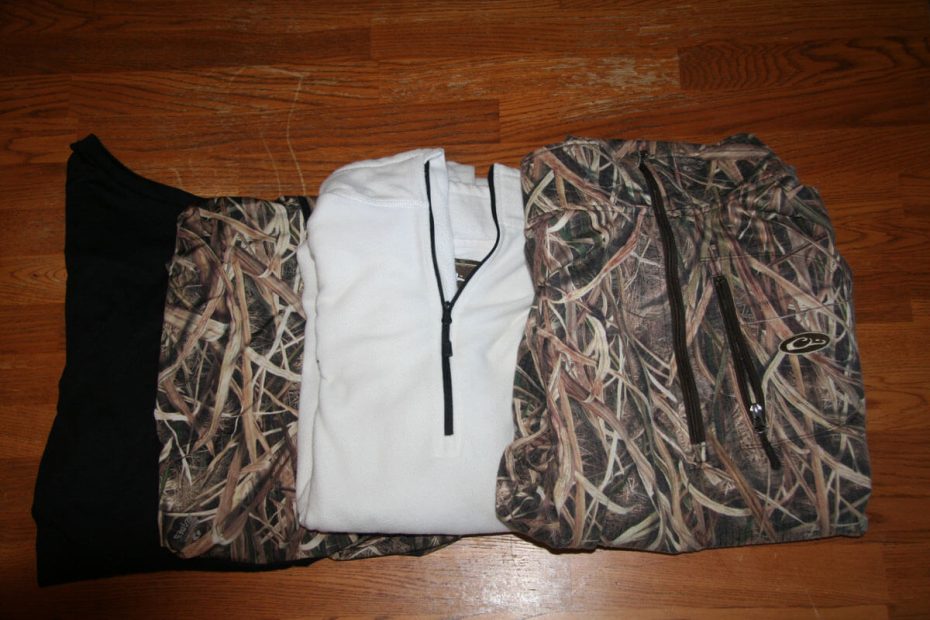Over the years I have experienced a wild variety of waterfowl clothing. Starting with those old cotton waffled long johns you can buy at the farm and home store. Not sure those ever kept me warm or dry. Once wet with either water or perspiration they stayed that way all day eventually cooling to the exterior temperature and making for a miserable day. I had friends that had down long johns and tops, but those too while keeping you warm could not breathe and once wet, were worse than cotton.

Let me start here with what is next to your skin and work outward. First off, NEVER wear a cotton T-shirt as a first layer. Cotton holds water and will not dry out inside your jacket or bibs. Same is true for what is against your legs – NO COTTON. I get it, cotton is the fabric of our lives, but best to wear it in the summer.

Keeping warm starts with a base layer. I prefer a base layer that starts the wicking process from your skin to the outer layer. Merino wool, polyester blends, polypropylene, and some measure of spandex for fit, start the layering process. You need something comfortable that resists moisture and wicks. Wool is one of the best but is also one of the most expensive. It has qualities, but I prefer either polyester or polypropylene next to my skin. This first layer can cover a large range of temperatures. While you may tend to be settled and seldom move about or you are extremely active and perspiring you begin your dress with a good base layer.
The upper body layering is hugely important to be warm and dry. I start with an 80% polyester and 20% Spandex closest to my skin. I feel slightly “sticky” with 100% polyester right next to my skin and I think you will feel the same. I add in next a 100% polyester layer then follow that with Polar Fleece. There are many thicknesses of fleece so pick one to meet the weather and temperature demand. At the upper end and on the coldest days I will use a “Sherpa” fleece that is lofted and warmer than thinner fleece.

From the base layer, you dress to be adaptable. By that I mean take off layers as needed to be comfortable. I also add the second layer as fleece. Of all the simple fabrics we have this one is remarkably adaptive to moisture. Fleece is polyester also known as polar fleece and as a warmth material, it is relatively new to us. The original manufacturer Malden Mills declined the patent and, therefore, we have ready access to this material in a wild variety of colors and styles. Polar fleece also comes in different pile thicknesses and several textures. The more loft or pile the more warning the material will provide.
In my youth, I ran a lot and on cold days wearing this simple two-layer clothing I would feel dry, and when I would return home my fleece would be completely frosted over. The proof that moisture was wicking its way from my skin to the outer layer of fabric.
The next layer gives you some options, but it should be breathable to continue to move moisture outward. On really cold days I use a down vest, but I may also opt for a synthetic down that includes a breathable fabric outer shell. The key here is layering so you control perspiration. In all layers, I suggest you have a way to unzip and bleed off heat if necessary. There will be times when removing layers is not practical. The weather may have changed, or you needed to chase down a wounded duck and you will need to get rid of heat quickly. Even the best materials have limitations.
The lower body is slightly different in that when wearing waders you have less opportunity to vent heat. If wearing bib overalls they will breathe, but keeping your skin dry helps avoid the clamminess otherwise present. Breathable waders work very well too.

One cannot forget your feet, as often they are the first things to get cold, and when cold they seem to stay cold until you can no longer stay outdoors. Here again, your feet need to be able to vent moisture away from your skin to help with dry heat. I use a thin sock lined with metal thread to hold heat but wick moisture out to the next layer of a wool blend sock or 100% wool sock. My head also needs to stay dry so I use a wicking material in my cap. A neck gaiter is also a great way to hold heat.


My outer layer is some type of water-proof fabric that breathes. There are several proprietary materials, but select one that works best for you at a price you can afford. Take good care of this outer shell or jacket as rainy days require double the moisture protection. You must keep the rain out and your perspiration out at the same time. Trust me; it can be done, and you can be warm and comfortable even in the harshest conditions.

Your choice of what to wear each day starts the night before by checking the weather and being prepared. Even though I religiously do this, I sometimes get it wrong or find myself overheating or being cold. For this reason, I always carry a dry bag to put a dry first layer in or an additional layer. Have a great waterfowl season and do not fear the cold!
